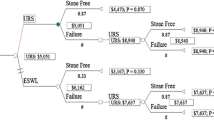Abstract
To evaluate patient’s characteristics that affects their decision on the management of asymptomatic renal calculi, and to determine the impact of anesthetic on the selection of shockwave lithotripsy (SWL). A survey was distributed to 100 patients in our multi-disciplinary stone clinic. The patients were given a hypothetical scenario of an asymptomatic 8 mm lower pole stone and descriptions for managements options including active surveillance (annual radiography, 40 % chance of growth >10 mm within 4 years, 20 % chance of passage), SWL under conscious sedation (65 % success rate), and URS (90 % success rate, with stent placement for 1 week). Patients were asked what was the most important variable impacting the choice of treatment. Patients preferred SWL (45 %) over URS (32 %) and active surveillance (23 %). Patients with a previous experience with URS were more likely to choose it again (p = 0.0433). Decisions were driven primarily by success rate (52 %), followed by risk of complications (29 %), postoperative pain (7 %) and others (12 %). Patients choosing URS had the highest magnitude of history of pain (p = 0.03) and were more likely to prioritize success (78 %) and less likely to prioritize surgical risk (13 %) or anticipated pain after surgery (0 %) (p = 0.01). Most (85 %) of the patients would rely on the physician’s recommendation for the treatment modality. Patients place differing value on risk versus success. As they rely heavily on the physician’s recommendation, it is important that their urologist determine whether risk or success is of highest priority for them to facilitate a shared medical decision.
Similar content being viewed by others
References
Preminger GM, Tiselius HG, Assimos DG et al (2007) Guideline for the management of ureteral calculi. J Urol 178:2418–2434
Saigal CS, Joyce G, Timilsina AR (2005) Direct and indirect costs of nephrolithiasis in an employed population: opportunity for disease management? Kidney Int 68:1808–1814
Goldsmith ZG, Lipkin ME (2012) When (and how) to surgically treat asymptomatic renal stones. Nat Rev Urol 27 9(6):315–320
Lingeman JE, Siegel YI, Steele B, Nyhuis AW, Woods JR (1994) Management of lower pole nephrolithiasis: a critical analysis. J Urol 151:663
Albala DM, Assimos DG, Clayman RV, Denstedt JD, Grasso M, Gutierrez-Aceves J et al (2001) Lower pole I: a prospective randomized trial of extracorporeal shock wave lithotripsy and percutaneous nephrostolithotomy for lower pole nephrolithiasis—initial results. J Urol 166:2072
Burgher A, Beman M, Monga M et al (2004) Progression of nephrolithiasis: long-term outcomes with observation of asymptomatic calculi. J Endourol 18(6):534–539
Sarkissian C, Noble M, Monga M et al (2013) Patient decision making for asymptomatic renal calculi: balancing benefit and risk. Urology 81(2):236–240
Joshi HB, Stainthorpe A, Keeley FX Jr et al (2001) Indwelling ureteral stents: evaluation of quality of life to aid outcome analysis. J Endourol 15:151–154
Tiselius HG, Alken P, Buck C et al (2009) Active removal of stones in the kidney. In: Guidelines on Urolithiasis. European Association of Urology, pp 24–37.
Lindhiem O, Bennett CB, Christopher J, Trentacosta et al (2014) Client preferences affect treatment satisfaction, completion, and clinical outcome: a meta-analysis. Clin Psychol Rev 34:506–517
Greenfield S, Kaplan S, Ware JE (1985) Expanding patient involvement in care: effects on patient outcomes. Ann Intern Med 102:520–528
Szasz TS, Hollender MH (1956) A contribution to the philosophy of medicine: the basic models of the doctor–patient relationship. Arch Intern Med 97:585–592
Strohmaier WL, Schubert G, Rosenkranz T et al (1999) Comparison of extracorporeal shock wave lithotripsy and ureteroscopy in the treatment of ureteral calculi: a prospective study. Eur Urol 36(5):376–379
Sener NC, Bas O, Sener E et al (2015) Asymptomatic lower pole small renal stones: shock wave lithotripsy, flexible ureteroscopy, or observation? A prospective randomized trial. Urology 85(1):33–37
Keeley FX Jr, Tilling K, Elves A et al (2001) Preliminary results of a randomized controlled trial of prophylactic shock wave lithotripsy for small asymptomatic renal calyceal stones. BJU Int 87(1):1–8
Pearle MS, Lingeman JE, Leveillee R et al (2008) Prospective randomized trial comparing shock wave lithotripsy and ureteroscopy for lower pole caliceal calculi 1 cm or less. J Urol 179(suppl 5):S69–S73
Author information
Authors and Affiliations
Corresponding author
Ethics declarations
Funding
This study was not funded.
Conflict of interest
None.
Ethical approval
All procedures performed in studies involving human participants were in accordance with the ethical standards of the institutional and/or national research committee (institutional review board) and with the 1964 Helsinki declaration and its later amendments or comparable ethical standards.
Informed consent
Informed consent was obtained from all individual participants included in the study.
Electronic supplementary material
Below is the link to the electronic supplementary material.
Rights and permissions
About this article
Cite this article
Omar, M., Tarplin, S., Brown, R. et al. Shared decision making: why do patients choose ureteroscopy?. Urolithiasis 44, 167–172 (2016). https://doi.org/10.1007/s00240-015-0806-0
Received:
Accepted:
Published:
Issue Date:
DOI: https://doi.org/10.1007/s00240-015-0806-0




